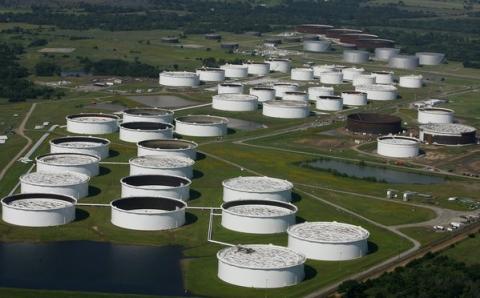You may have heard that Cushing, Oklahoma is no longer the center of the crude oil universe. The logic goes that WTI is no longer representative of the world crude oil price. …The WTI-Brent arbitrage is broken. …NYMEX and ICE are looking for trading hubs to replace Cushing. ….The days of WTI as a hedging vehicle for everything between jet fuel in Wisconsin to crude oil production in Latin America are ancient history. ….Rail cars from the Bakken are moving to St. James, LA or Albany, NY. …Certainly not Cushing, OK. ….All the shale oil barrels want to get to the huge Gulf Coast refinery complex, bypassing Cushing. ….It is only a matter of time before Cushing devolves into a dusty Oklahoma town with a lot of rusting tanks. …And all crude oil will trade against St. James, or Brent, or some new Gulf Coast index.
This week I spoke at the Platts North American Crude Oil Marketing Conference in Houston. It was well attended with a lot of engaging presentations. The “What happens to Cushing?” theme came up time and time again. Although sentiment was far from unanimous, the general consensus and the market evidence clearly indicates that rumors of Cushing’s demise are greatly exaggerated. In fact, Cushing, Oklahoma is doin’ fine. There’s plen’y of air and plen’y of room --- to build more storage capacity, more rail racks, more inbound pipelines, and more outbound pipelines. That is exactly what is happening.

One of the most informative presentations was from Abudi Zein, Genscape SVP. For the past three years, Genscape has been collecting data on crude oil storage facilities in North America by doing frequent airplane flyovers and infrared photography. It is a fascinating fundamentals data acquisition model that covers all of the major above ground storage hubs. Only St. James (where most of the crude is in underground caverns) is underneath the Genscape radar.
Some of the key points from Abudi’s presentation follow:
- About 126 MM barrels of U.S. and Canadian crude oil storage are visible to the Genscape system. More than 50% of the total, or 67 MM barrels of the total are in Cushing. That is up from 54 MM barrels only one year ago.
- The next largest storage hub is Hardesty at 17 MM, followed (in order of size) by Patoka, Edmonton, Midland, Wichita Falls, Colorado City, Hardisty-Caverh, Kerrobert, and Wink.
- Today about 11 MM barrels of new storage capacity are physically under construction at Cushing. That is 65% of all the hub-based, above-ground crude tankage being built in North America. The construction sites are tracked by Genscape’s aerial photography. In addition to Cushing, there are about 3 MM bbls under construction at Hardesty, and around 1 MM bbls each at Edmonton, Midland, and Patoka.
- Capacity utilization at all of the facilities is well below 100%. Today Cushing is about 55%, down from 80% this time last year. Utilization of most other facilities this year is 40-50%. The highest is Midland at 75%.
A few other fun facts from other presentations:
- There are several unit train terminals (100+ rail car loading facilities) being built in the Bakken to relieve pipeline transportation constraints in the region. (see A Perfect Storm in the Bakken.) There are only two places in the country that can handle receipt of these unit trains without breaking them up and losing the efficiencies of unit train transportation: St. James, LA (home of Light Louisiana Sweet) and Stroud near Cushing, OK (home of West Texas Intermediate and the CME/NYMEX futures delivery point). Few refineries have the available land necessary to build one of these facilities. [James Cairns, Vice President, Petroleum and Chemicals, CN Rail]
- Most of the big crude oil pipeline projects in the works around the country move barrels into or out of Cushing: Enterprise/ Enbridge Seaway Reversal (Cushing to Gulf), Plains Basin (Permian to Cushing), Kinder Morgan Pony Express (Guernsey, WY to Cushing), Enbridge Flanagan (Flanagan, IL to Cushing), and of course TransCanada’s Keystone XL (Canada/Bakken to Cushing to Gulf). [various presentations].
- Raymond James is forecasting that U.S. oil production (excluding NGLs) will grow from 5.6 MMb/d in 2010 to a “whopping” 9.1 MMb/d in 2015, or 3.5 MMb/d growth. This is a huge number, significantly higher than most other forecasts. (For reference, Bentek is projecting 2.2 MMb/d by 2016). The Raymond James number for the Bakken/ Williston is 1.6 MMb/d in 2015. [Cory Garcia, Associate Analyst, Energy Equity Research, Raymond James Equity Research] Even though the Raymond James number is high, it received more support from conference participants than pushback.
What does all of this mean for the crude oil market in general, and for Cushing, OK in particular? It means that Cushing is OK. In fact, very well indeed. Cushing is and will remain the center of the crude oil business in North America.
- It is big. Excluding the government’s Strategic Petroleum Reserve, Cushing is by far the largest crude oil storage facility on the continent. Even with the change in crude oil flows from south-to-north to north-to-south, Cushing is at the balancing point between crude producers and refiners. Much of the new pipeline and rail construction reinforces Cushing’s position as the central exchange for physical crude oil barrels in North America (N.A.).
- Storage operators and pipelines are investing in Cushing at a rate many times any other hub. If investment dollars are any indication (and they are) there is no evidence that the industry is backing off Cushing as the premiere crude oil trading hub.
- Today the utilization of Cushing (and other N.A. hub) storage is down, reflecting economics of the WTI forward curve. The first four months (May-Aug 2012) are in contango, but less than the $.60/bbl rule-of-thumb monthly cost of leasing storage capacity. Beyond that, the market is backwardated. Back when storage utilization was north of 80%, much steeper contango made it highly profitable to store barrels. That economic incentive is gone now, but it will be back. Once geopolitical risk dies down, increasing shale production will move the market back to contango. That will again make storing barrels a profitable trade.
- The quality of many of the new shale crudes are different from traditional crudes, and are relatively unstable (they change from day to day because of the variability from well to well). Both of these trends are bad things for refineries that want a steady diet of a few classic crude blends. For this reason, much more tankage will be needed for breakout storage, blending and general operation of the crude transportation grid. Cushing is the place where most of this will happen.
- Whether or not you believe the Raymond James projection or some other number, there is no doubt that crude oil in N.A. is seeing a huge surge of production that will extend for a very long time. This fact, and the advantages that it will bring to the already dominant U.S. position in crude oil refining means that the influence of U.S. prices in global markets is on the rise.
- And don’t forget, trading volumes and open interest on the CME/NYMEX continue at record levels. There is still no more liquid trading point on the planet.
The importance of Cushing in crude oil markets is growing, not shrinking. So next time you hear someone say Cushing is history as the major crude trading hub, I recommend that you break out in song.
We know we belong to the land. And the land we belong to is grand!
And when we say -- Yeeow! Ayipioeeay!
We're only sayin' You're doin' fine, Oklahoma!
Oklahoma O.K.
-------
BTW, If you are in the Tulsa, OK area, and want to see a sensational outdoor performance of Rodgers and Hammerstein's OKLAHOMA!, check out Discoveryland. http://www.discoverylandusa.com/






